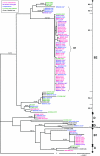Extraintestinal pathogenic Escherichia coli strains of avian and human origin: link between phylogenetic relationships and common virulence patterns
- PMID: 17652485
- PMCID: PMC2045314
- DOI: 10.1128/JCM.00037-07
Extraintestinal pathogenic Escherichia coli strains of avian and human origin: link between phylogenetic relationships and common virulence patterns
Abstract
Extraintestinal pathogenic Escherichia coli (ExPEC) strains of human and avian origin show similarities that suggest that the avian strains potentially have zoonotic properties. However, the phylogenetic relationships between avian and human ExPEC strains are poorly documented, so this possibility is difficult to assess. We used PCR-based phylotyping and multilocus sequence typing (MLST) to determine the phylogenetic relationships between 39 avian pathogenic E. coli (APEC) strains of serogroups O1, O2, O18, and O78 and 51 human ExPEC strains. We also compared the virulence genotype and pathogenicity for chickens of APEC strains and human ExPEC strains. Twenty-eight of the 30 APEC strains of serogroups O1, O2, and O18 were classified by MLST into the same subcluster (B2-1) of phylogenetic group B2, whereas the 9 APEC strains of serogroup O78 were in phylogenetic groups D (3 strains) and B1 (6 strains). Human ExPEC strains were closely related to APEC strains in each of these three subclusters. The 28 avian and 25 human strains belonging to phylogenetic subcluster B2-1 all expressed the K1 antigen and presented no significant differences concerning the presence of other virulence factors. Moreover, human strains of this phylogenetic subcluster were highly virulent for chicks, so no host specificity was identified. Thus, APEC strains of serotypes O1:K1, O2:K1, and O18:K1 belong to the same highly pathogenic clonal group as human E. coli strains of the same serotypes isolated from cases of neonatal meningitis, urinary tract infections, and septicemia. These APEC strains constitute a potential zoonotic risk.
Figures



References
-
- Adiri, R. S., U. Gophna, and E. Z. Ron. 2003. Multilocus sequence typing (MLST) of Escherichia coli O78 strains. FEMS Microbiol. Lett. 222:199-203. - PubMed
-
- Arné, P., D. Marc, A. Brée, C. Schouler, and M. Dho-Moulin. 2000. Increased tracheal colonization in chickens without impairing pathogenic properties of avian pathogenic Escherichia coli MT78 with a fimH deletion. Avian Dis. 44:343-355. - PubMed
-
- Barnes, H. J., J.-P. Vaillancourt, and W. B. Gross. 2003. Colibacillosis, p. 631-652. In Y. M. Saif, H. J. Barnes, J. R. Glisson, A. M. Fadly, L. R. McDougald, and D. E. Swayne (ed.), Diseases of poultry, 11th ed. Iowa State University Press, Ames, IA.
-
- Blanco, J. E., M. Blanco, A. Mora, W. H. Jansen, V. Garcia, M. L. Vazquez, and J. Blanco. 1998. Serotypes of Escherichia coli isolated from septicaemic chickens in Galicia (northwest Spain). Vet. Microbiol. 61:229-235. - PubMed
Publication types
MeSH terms
LinkOut - more resources
Full Text Sources

